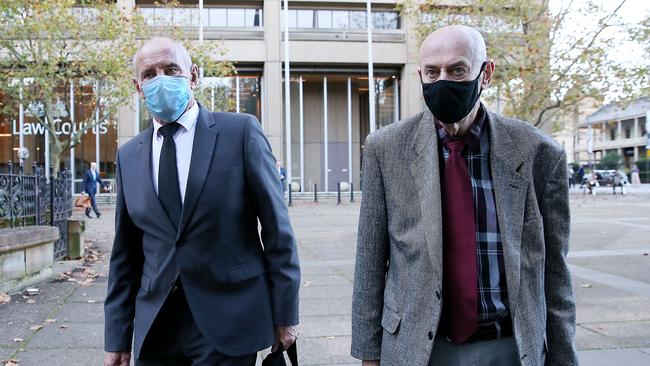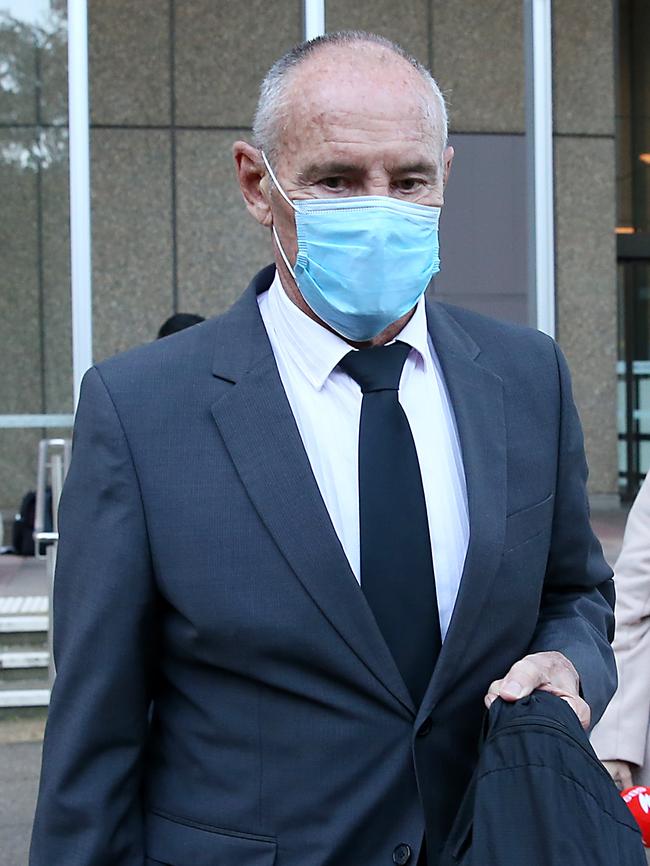Chris Dawson trial: Curtains part to reveal suburban drama
The court, like so many court rooms, is a model of non-distracting decor – grey carpet, beige faux-leather chairs, pale wood panelling offset by cream walls. But things were about to get extremely colourful.

At 8.41am on Monday Christopher Michael Dawson, in a charcoal grey suit and donning a powder blue face mask, made his way past the busy Le Jardin coffee wagon in Sydney’s Queens Square, through scuds of dead tree leaves, and to the steps of the Law Court building just off Macquarie St in the CBD.
Dawson, along with his brother Paul, was on his way to the first day of witness evidence in his murder trial. He has pleaded not guilty to killing his former wife Lynette in 1982.
The former Newtown Jets rugby league player and school physical education teacher – two careers that may explain his shuffling gait and facial skin clearly exposed to long bouts of sun – then made his way up to Supreme Court 9D.
The court, like so many court rooms, is a model of non-distracting decor – grey carpet, beige faux-leather chairs, pale wood panelling offset by cream walls. But things were about to get extremely colourful.
Just before the 9.30am start, of the 14 chairs that constituted the public gallery, only five were occupied. Dawson, 73, consulted his legal counsel in Meeting Room 9.03 just near the court entrance.
He entered the court proper clutching what appeared to be a small black backpack, and after a moment of confusion about his seating, was directed to the left side of the court and found his place beneath the room’s round black and white clock.
In front of him, his barrister Pauline David adjusted her horsehair; crown prosecutor Craig Everson SC flicked his own on with a dramatic flourish that must have gone largely unappreciated, given Dawson’s trial is judge-alone, and without the presence of a jury.
The Honourable Justice Ian Harrison then entered with a brisk efficiency and took his seat. He has, from a distance, what you might call a poker face. Direct. Unflinching.
But as proceedings unfolded, he exposed a highly animated relationship between his hands and his face, or more accurately his chin. He would hold his head with the left hand, then the right, then just two fingers as support, then a single bunched fist, then with the thumbs of both hands held in front of his lower face.
Through the course of the day he would also show his vintage with a string of delightfully arcane phrases that have been lost to the Australian vernacular. Jolly good, the judge said. Call me old fashioned. All hands to the pump. All could have leapt from a Biggles novel.
Then, at 9.46am Ms David addressed the court in her opening address for the defence.
Chris Dawson, the accused, she said, did not kill Lynette Dawson. He may have failed her as a husband, but he did not kill her.
She pointed out that during the four decades that Lynette had been missing, witness had died, other important witnesses had been ignored, police investigations had failed, there had been unexplained delays, records had been lost and there had been a failure to follow significant leads of signs of life in relation to Lyn Dawson.
There had been “wilful” disregard by “some” police, she said.

At 10.30am precisely, the first witness, Julie May Andrew, was called. She was petite, wearing a black and red patterned outfit, black stockings, black shoes and a black mask. Her hair was dark and cropped short.
And she too was unflinching. Throughout her evidence she would refer to herself as “not a woman” prone to flattery, prone to be easily influenced, prone to any number of perceived temptations. In short, a straight shooter.
Julie Andrew was a friend and neighbour of the Dawsons in Bayview Heights, on Sydney’s northern beaches. Her property shared a fence line with Lyn’s, and once they became friends they established a shortcut to each other’s houses through a stand of she-oaks.
Both women had young children, and Ms Andrew’s evidence evoked a vanished Australian era: a time when neighbours slipped over and into each other’s kitchens for a cup of a tea and a gossip.
Long, hot summers with children squealing in the pool. Women who stayed at home to look after the kids and lived on tight household budgets controlled by their husbands. Buying things on your Bankcard. Decorating your home with massive ferns spilling frompots hanging from the ceiling. Women wearing G-strings and swimming topless.
Amid all this, Ms Andrew developed a relationship with Lyn Dawson.
How was Lyn as a mother?
“She was very caring, very loving … a patient mother. She was an inspiration,” Ms Andrew told the court.
Did she have any interaction with Lyn’s husband Chris? No.
She said she witnessed, from her own yard, a fight between Lyn and Chris out by their kids’ trampoline one weekday morning. She said she heard a “wail” and alleged that Chris was towering over his wife, screaming at her. Ms Andrew alleged she heard Lyn say to one of her children immediately after the fight: “God” or “gosh, what’s Daddy doing to us?”
Ms Andrew said she later went over to make sure Lyn was all right.

“She was putting on a brave front and put the kettle on for a cup of tea,” Ms Andrew added. Lyn allegedly told her neighbour she was upset because JC, the young family babysitter, was moving permanently into the house.
“I said you’ve got to get rid of her,” Ms Andrew told the court. “I’m not a woman prone to swearing but I said Lyn, you can’t have her move in here, he’s (Chris) f..king the babysitter.”
Ms Andrew’s evidence underlined the narrative that built throughout the day. The court had travelled back 40 years in time and was now peering behind the curtains of a deeply suburban and somewhat salacious human drama.
During the lunch break, Chris Dawson struck up a conversation with a man in the public gallery. They shook hands as they parted and someone said: “Good luck, buddy, God bless you.”
When court resumed, barrister David and Ms Andrew had some memorable exchanges.
You are incapable of coming to this court and giving impartial evidence, Ms David said. No was the reply.
Q: You’ve come here to portray Chris Dawson as a monster. A: I’ve come here to tell the truth.
Prosecutor Everson later asked Ms Andrew why, when she realised perhaps something was amiss with Lyn and that she was no longer around although her children were still at the house, she didn’t knock on the Dawson front door to check on her welfare, or leave a note in the letterbox, or even call the police.
She told the court: “Forty years ago was a very different time for women. Women were disenfranchised. I had no experience of family breakdown or domestic violence or police for that matter.
“I waited for someone to knock at my door. I waited for someone to say, she’s gone, where is she?
“Why didn’t anyone come and ask me? No one asked me. To my great regret and shame I didn’t do anything about it.”
By this stage, Chris Dawson, after a long day, was leaning slightly forward in his chair, his hands clasped together in his lap.
Lyn’s older sister, Patricia Jenkins, will resume her evidence via videolink on Tuesday.




